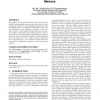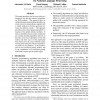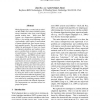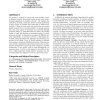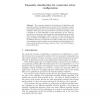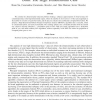EMSOFT
2010
Springer
14 years 3 months ago
2010
Springer
We propose the first polynomial-time code selection algorithm for minimising the worst-case execution time of a nonnested loop executed on a fully pipelined processor that uses sc...
EMNLP
2010
14 years 3 months ago
2010
This paper introduces dual decomposition as a framework for deriving inference algorithms for NLP problems. The approach relies on standard dynamic-programming algorithms as oracl...
EMNLP
2010
14 years 3 months ago
2010
This paper introduces algorithms for nonprojective parsing based on dual decomposition. We focus on parsing algorithms for nonprojective head automata, a generalization of head-au...
EMNLP
2010
14 years 3 months ago
2010
Word alignment plays a central role in statistical MT (SMT) since almost all SMT systems extract translation rules from word aligned parallel training data. While most SMT systems...
ECIR
2010
Springer
14 years 3 months ago
2010
Springer
Abstract. Machine learning ranking methods are increasingly applied to ranking tasks in information retrieval (IR). However ranking tasks in IR often differ from standard ranking t...
DMIN
2010
14 years 3 months ago
2010
Recently Vapnik et al. [11, 12, 13] introduced a new learning model, called Learning Using Privileged Information (LUPI). In this model, along with standard training data, the tea...
DIALM
2010
ACM
14 years 3 months ago
2010
ACM
We present a method for using real world mobility traces to identify tractable theoretical models for the study of distributed algorithms in mobile networks. We validate the metho...
CP
2010
Springer
14 years 3 months ago
2010
Springer
The automatic tuning of the parameters of algorithms and automatic selection of algorithms has received a lot of attention recently. One possible approach is the use of machine lea...
COLT
2010
Springer
14 years 3 months ago
2010
Springer
A significant Fourier transform (SFT) algorithm, given a threshold and oracle access to a function f, outputs (the frequencies and approximate values of) all the -significant Fou...
COLT
2010
Springer
14 years 3 months ago
2010
Springer
We consider the dimensionality-reduction problem (finding a subspace approximation of observed data) for contaminated data in the high dimensional regime, where the number of obse...
